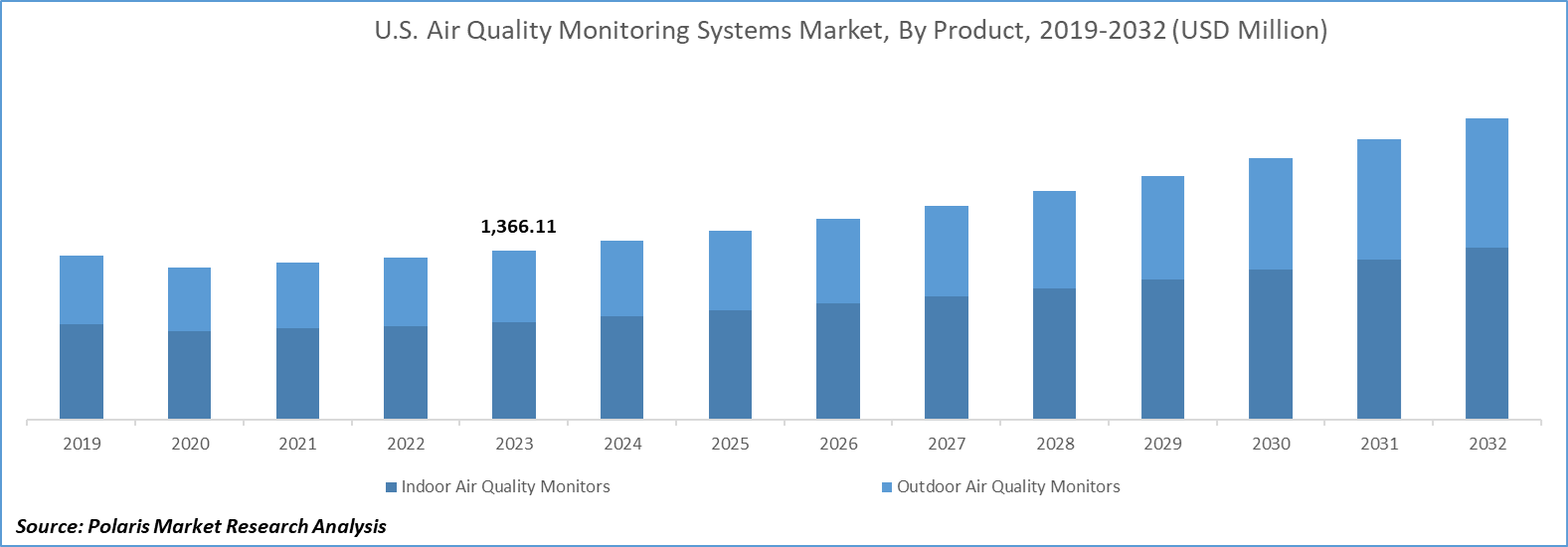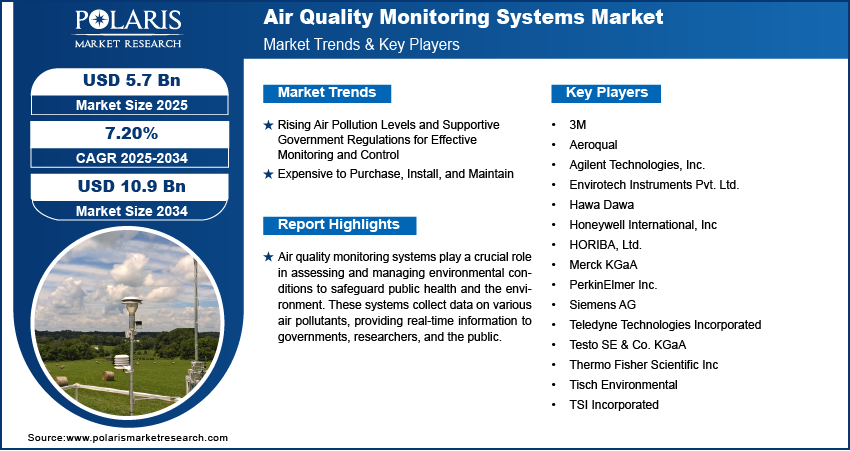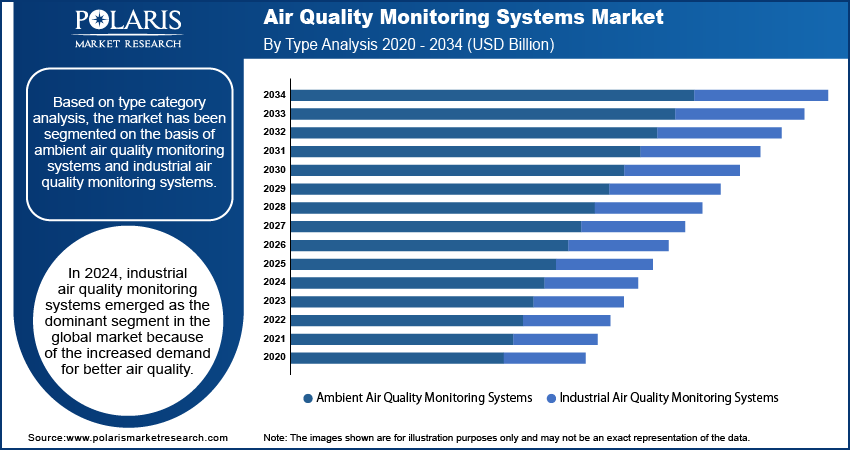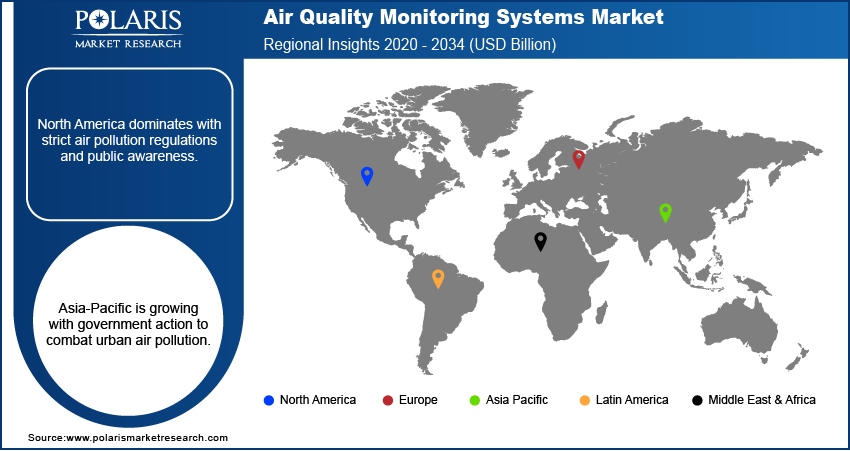
Air Quality Monitoring System Market Share, Size, Trends, Industry Analysis Report, By Type (Ambient Air Quality Monitoring Systems, Industrial Air Quality Monitoring Systems); By Product; By Sampling Method; By Pollutants; By End-Use; By Region; Segment Forecast, 2024 - 2032
- Published Date:Jun-2024
- Pages: 118
- Format: PDF
- Report ID: PM2210
- Base Year: 2023
- Historical Data: 2019-2022
Report Outlook
Air quality monitoring system market size was valued at USD 4,809.41 million in 2023. The market is anticipated to grow from USD 5,097.98 million in 2024 to USD 8,693.36 million by 2032, exhibiting the CAGR of 6.8% during the forecast period.
Industry Trends
Air quality monitoring systems play a crucial role in assessing and managing environmental conditions to safeguard public health and the environment. These systems collect data on various air pollutants, providing real-time information to governments, researchers, and the public. Air quality monitoring systems are designed to measure and analyze the concentration of various air pollutants, such as particulate matter (PM), nitrogen dioxide (NO2), sulphur dioxide (SO2), carbon monoxide (CO), ozone (O3), and volatile organic compounds (VOCs). These systems typically consist of a network of monitoring stations equipped with specialized instruments. Key components of an air quality monitoring system include sensors and instruments, data transmission, data analysis, and reporting & alerts.

To Understand More About this Research:Request a Free Sample Report
Furthermore, Air quality monitoring systems play a pivotal role in addressing public health concerns by providing real-time data on the levels of various air pollutants. As urbanization and industrialization continue to rise, the quality of the air we breathe has become a critical issue, with far-reaching implications for human health and well-being. These monitoring systems offer valuable insights, enabling informed decision-making and the implementation of effective policies to mitigate the adverse effects of air pollution.
In recent years, advancements in technology have revolutionized air quality monitoring. Traditional stationary monitoring stations have been complemented by portable sensors, wearable devices, and even satellite-based measurements. This expansion of monitoring capabilities provides a more comprehensive view of air quality, enabling the identification of pollution hotspots and the tracking of pollution sources over larger geographic areas.
Key Takeaways
- North America dominated the market and contributed over 32% market share of the air quality monitoring system market size in 2023
- By type category, the industrial air quality monitoring systems segment dominated the global air quality monitoring system market size in 2023
- By end-use category, the commercial segment is projected to grow with a significant CAGR over the air quality monitoring system market forecast period
What are the Market Drivers Driving the Demand for Market?
Rising Air Pollution Levels and Supportive Government Regulations for Effective Monitoring and Control Drive Market Growth
Air pollution is a major global problem. The World Health Organization reports that 90% of people breathe polluted air, causing 7 million deaths yearly from outdoor and indoor air pollution. Nearly all people worldwide (99%) breathe air with high levels of pollutants exceeding WHO guideline limits, with low- and middle-income countries facing the highest exposures.
The global focus on effective air pollution monitoring has increased in the last two decades. Rising public awareness and demand for advanced air quality monitoring devices have led to increased focus for governments and private companies to develop accurate, affordable air quality monitors. With the economic expansion of emerging countries and rising GDP per capita, many governments are implementing new air pollution monitoring and control measures to improve the living standards of their citizens. This can help reduce pollution and limit air pollution-related health risks. Various organizations, including government agencies, NGOs such as EDF, and private companies, use air sensors and real-time quality monitoring devices to map air quality on a hyperlocal scale.
Which Factor is Restraining the Demand for the Market?
Expensive to Purchase, Install, and Maintain
Air quality monitoring systems can be expensive to purchase, install, and maintain. The cost includes purchasing monitoring equipment, establishing infrastructure, maintaining instruments, and regularly calibrating and updating the systems.
Industry-standard air quality devices can cost thousands of dollars, while cheaper ones may offer superior accuracy and reliability. Due to budget constraints, governments and organizations may need assistance establishing sufficient monitoring stations. Therefore, some regions may need additional monitoring to avoid gaps in comprehending pollution levels and sources. It is crucial to perform regular maintenance and calibration of monitoring devices to ensure their accuracy and reliability. However, maintaining and calibrating the instruments can be prohibitive for some regions or municipalities. A typical air quality monitoring sensor assesses indoor and outdoor air quality parameters, such as particulate matter, temperature, gaseous compounds, humidity, etc. Detection of these requires advanced technologies, which can be high-priced and further increased by device miniaturization. Collaborations between the public and private sectors can help share the cost burden and promote the development of more affordable monitoring solutions.

Report Segmentation
The market is primarily segmented based on type, product, sampling method, pollutants, end-use, and region.
|
By Type |
By Product |
By Sampling Method |
By Pollutants |
By End-Use |
By Region |
|
|
|
|
|
|
To Understand the Scope of this Report:Speak to Analyst
Category Wise Insights
By Type Insights
Based on type category analysis, the market has been segmented on the basis of ambient air quality monitoring systems and industrial air quality monitoring systems. In 2023, industrial air quality monitoring systems emerged as the dominant segment in the global market because of the increased demand for better air quality. The World Health Organization (WHO) predicted that by 2022, air pollution-related deaths would account for 4.2 million annual deaths. All living things are affected by rising air pollution levels, which are a public health problem. Urban areas tend to have the highest concentrations of harmful gases. In 2022, environmental pollution was an undeniable concern. Air pollution affects people's mental and physical health, and chronic exposure raises the risk of cardiovascular and respiratory disorders. From an industrial standpoint, factories and other industrial facilities release significant organic gases into the atmosphere, including carbon monoxide, hydrocarbons, and chemicals. Climate change caused by greenhouse gas emissions is a global problem that significantly impacts natural resources, human health, and economic development. During the projected period, these key factors are anticipated to propel the industrial air quality monitoring system market.
By End-Use Insights
Based on end-use category analysis, the market has been segmented on the basis of residential, commercial, and industrial. The commercial segment is anticipated to grow with a significant CAGR in the forecasted years. Commercial air quality monitoring involves assessing and managing indoor air quality in various commercial settings, such as office buildings, shopping malls, hospitals, hotels, restaurants, and other public spaces. This type of monitoring is important for ensuring the health, comfort, and well-being of occupants and visitors in commercial buildings. Commercial air quality monitoring is essential for maintaining a healthy, productive, and comfortable indoor environment in various commercial settings.
Poor indoor air quality can lead to health issues and potential legal liabilities for building owners and employers. Monitoring air quality helps identify and address potential sources of pollution, reducing the risk of legal disputes. Commercial buildings seeking green certifications, such as LEED (Leadership in Energy and Environmental Design), must demonstrate their commitment to environmental sustainability, including maintaining high indoor air quality standards. Businesses are increasingly aware of the "sick building syndrome phenomenon," where occupants experience health issues due to poor indoor air quality. In summary, the commercial air quality monitoring segment is driven by health awareness, regulatory requirements, environmental concerns, and the desire to create safe, productive, and sustainable indoor environments for employees, customers, and occupants.

Regional Insights
North America
North America accounted for the largest revenue share in the global market due to the combination of environmental concerns, regulatory initiatives, and technological advancements. Growing public awareness about the health risks associated with air pollution has intensified the need for air quality monitoring. Concerned citizens and advocacy groups are increasingly vocal about the quality of the air they breathe, prompting governments and industries to invest in comprehensive monitoring systems. Moreover, technological advancements have also played a pivotal role in shaping the North American air quality monitoring systems market. Advances in sensor technology, data analytics, and communication infrastructure have made monitoring systems more efficient, affordable, and accessible. This has not only benefited government agencies and industrial facilities but has also empowered individuals to monitor air quality on a smaller scale.
Asia Pacific
The Asia Pacific region has been experiencing significant growth in air quality monitoring systems due to increasing concerns about air pollution and its impact on public health and the environment. Air quality monitoring systems are designed to measure various air pollutants and provide real-time data to government agencies, industries, and the general public. Many countries in the Asia Pacific region, particularly densely populated urban areas, have been grappling with high levels of air pollution caused by industrial activities, vehicular emissions, and other sources. This has increased awareness of the need for accurate air quality monitoring.

Competitive Landscape
Industry leaders are continuously improving their product offerings by incorporating precision, portability, and real-time data analysis capabilities. At the same time, new startups are disrupting the market with advanced sensor technologies and cloud-based solutions. To stay ahead of the competition, players are partnering with government bodies and research institutions for data validation and calibration, thus intensifying the competition further.
Some of the major players operating in the global market include:
- 3M
- Aeroqual
- Agilent Technologies, Inc.
- Envirotech Instruments Pvt. Ltd.
- Hawa Dawa
- Honeywell International, Inc
- HORIBA, Ltd.
- Merck KGaA
- PerkinElmer Inc.
- Siemens AG
- Teledyne Technologies Incorporated
- Testo SE & Co. KGaA
- Thermo Fisher Scientific Inc
- Tisch Environmental
- TSI Incorporated
Recent Developments
- In March 2023, Siemens Smart Infrastructure launched the Connect Box—an accessible IoT solution for small to medium-sized buildings. A part of the Siemens Xcelerator portfolio, it simplifies building performance monitoring, potentially boosting energy efficiency by 30% and significantly enhancing indoor air quality in spaces like schools, retail shops, and small offices.
- In February 2022, Honeywell launched an Indoor Air Quality (IAQ) monitor that notifies building operators about potential concerns, aiding in enhancing indoor air quality and potentially reducing airborne transmission risks; this Made in India device measures temperature, humidity, air pollutants, and offers an IAQ index.
- In February 2020, TSI launched the cost-effective BlueSky Air Quality Monitor (Model 8143), expanding its environmental air monitoring solutions to measure various particle mass concentrations along with temperature and humidity.
- In September 2022, TSI Incorporated and Building4Health Inc. (B4H) partnered to merge TSI’s Indoor Air Quality technology with B4H’s medical and architectural expertise, offering real-time health insights for effective indoor environment management.
Report Coverage
The air quality monitoring system market report emphasizes on key regions across the globe to provide better understanding of the product to the users. Also, the report provides market insights into recent developments, trends and analyzes the technologies that are gaining traction around the globe. Furthermore, the report covers in-depth qualitative analysis pertaining to various paradigm shifts associated with the transformation of these solutions.
The report provides detailed analysis of the market while focusing on various key aspects such as competitive analysis, type, product, sampling method, pollutants, end-use, and their futuristic growth opportunities.
Air Quality Monitoring System Market Report Scope
|
Report Attributes |
Details |
|
Market size value in 2024 |
USD 5,097.98 million |
|
Revenue forecast in 2032 |
USD 8,693.36 million |
|
CAGR |
6.8% from 2024 – 2032 |
|
Base year |
2023 |
|
Historical data |
2019 – 2022 |
|
Forecast period |
2024 – 2032 |
|
Quantitative units |
Revenue in USD million and CAGR from 2024 to 2032 |
|
Segments covered |
By Type, By Product, By Sampling Method, By Pollutants, By End-Use, By Region |
|
Regional scope |
North America, Europe, Asia Pacific, Latin America, Middle East & Africa |
|
Customization |
Report customization as per your requirements with respect to countries, region, and segmentation. |
FAQ's
The key companies in Air Quality Monitoring Systems Market are 3M, Aeroqual, Agilent Technologies, Inc., Envirotech Instruments Pvt. Ltd., Hawa Dawa, Honeywell International
Air quality monitoring system market exhibiting the CAGR of 6.8% during the forecast period.
Air Quality Monitoring Systems Market report covering key segments are type, product, sampling method, pollutants, end-use, and region.
The key driving factors in Air Quality Monitoring Systems Market are Rising air pollution levels and supportive government regulations for effective monitoring and control drive market growth
Air Quality Monitoring System Market Size Worth USD 8,693.36 Million by 2032.
